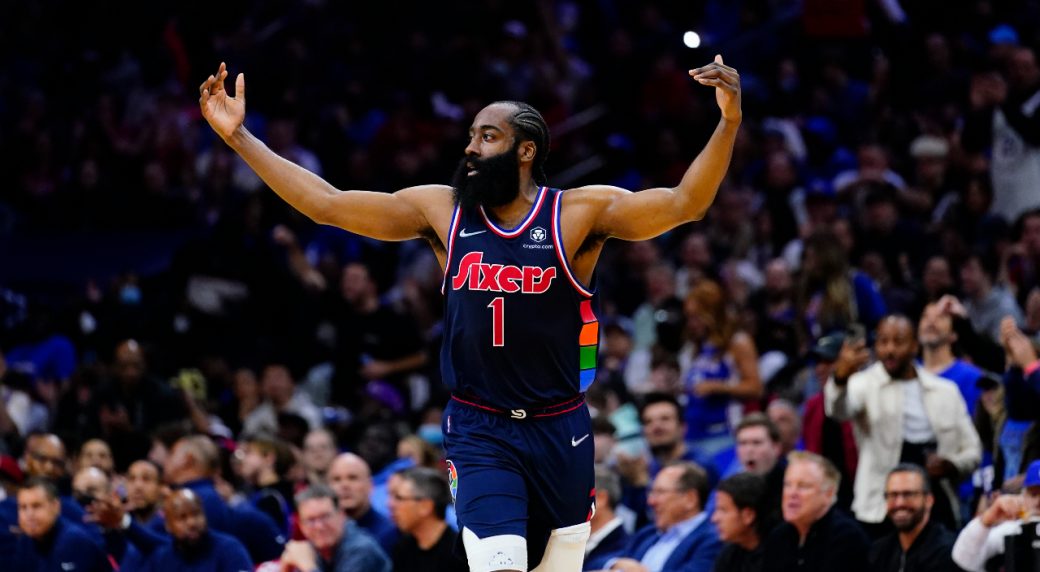
One of the great (read: nerdy, insular) parts about being a fan of a specific sports team is the sort of ownership over their history one innately feels.
A Toronto Raptors fan instinctively recalls 12 as the magic number of threes Donyell Marshall hit in 2005 whenever a player starts heating up from outside. Memphis Grizzlies fans had 45 in mind when Ja Morant was dominating on Feb. 26, and then again on Feb. 28 to break Mike Miller’s 15-year-old franchise scoring record.
Every team has their records, their statistical anomalies, and their numerical esoterica, items that seem nonsensical to the layman but are part of the pledge of allegiance within that fan circle.
James Harden is a wellspring in this regard, and he’s wasted no time providing Philadelphia 76ers fans with new benchmarks to follow and adjust.
It took Harden all of five games to take down his first 76ers mark, as he totalled more assists across those games than any Philadelphia player had in any five-game stretch over the last 20 years. He hit the ground running – and passing – with one of the most extreme playmaking stretches in the NBA this season.
In the fifth year of their perceived contention window, the 76ers are far beyond the point of hanging banners for statistical oddities. Flipping Ben Simmons, Seth Curry, Andre Drummond and a pair of first-round picks for Harden was not done to further enhance Daryl Morey’s imprint on the math of basketball. At least not primarily.
The 76ers need to compete for a championship, and they need to compete for a championship now, while 27-year-old Joel Embiid remains one of the best and most dominant two-way players in basketball (as well as the current MVP favourite).
But here’s the thing about Harden: His statistical enormity is exactly what makes him such a dangerous fit in Philly, even if it’s going to require some tinkering of their offensive system and hierarchy. The Sixers have won all five games Harden’s played, and some of the early statistical trends should have Eastern Conference opponents — including the Brooklyn Nets (Thursday 7:30 pm ET on Sportsnet One) — on alarm.
Harden as a playmaker
Assists on their own aren’t necessarily good or bad. More passing can lead to more turnovers, and ball movement has to exist to create advantages, not just for its own sake.
Still, peruse the assist leaderboard at the team level and you tend to find groups that are difficult to plan for. Since Harden’s arrival, Philadelphia has jumped from 22nd to sixth in the percentage of their field goals that are assisted, with nearly a 10-percent spike in assist rate.
This is where Harden’s impact has been most obvious out of the gate. The raw totals are impressive, with 62 helpers in 184 minutes, and Harden appears to be taking point guard duties as his primary responsibility as he gets acclimated. There’s been a concerted effort on his part to get teammates involved without as many of the more ball-dominant stretches we’ve become accustomed to during his stops in Houston, and to a lesser extent Brooklyn.
The Embiid factor
In raw totals, Embiid has been the largest recipient of Harden’s playmaking, with the pair connecting on 30 buckets (23 for Embiid, seven for Harden). That might look even more impressive if players were awarded assists when they help a teammate go to the free-throw line. Fouls aside, Embiid has turned 84 Harden passes into 50 field-goal attempts, and anecdotally he’s getting those attempts in advantageous positions.
That should be the norm against most opponents. Harden and Embiid are impossible defensive assignments on their own. Together, they bend the geometry of the basketball court. The strategy with Harden is often to double-team him high on the floor and get the ball out of his hands.
With Embiid, it’s to send double-teams right at the catch, limiting his ability to get deep position. Neither of those are particularly effective at doing more than stemming the bleeding. When you have to try to do both? Forget about it. There just aren’t enough defenders on the floor, and a high trap on Harden means one less body – or at least one body arriving later – if the ball gets through to Embiid.
That Embiid is himself a capable passer further exacerbates the issue, as Harden-Embiid pick-and-rolls require three players to defend. And either is comfortable screening, scoring, or passing out of those situations.
Harden and Embiid will make life easier for each other, and their synergy should leave a lot of complementary players very open in the weeks to come.
The Maxey effect
Perhaps nobody has benefitted from Harden’s change of scenery more than Tyrese Maxey, Philadelphia’s sophomore guard. While six-foot-two and billed as a point guard, Maxey has often looked at his best when only tasked with secondary playmaking, instead focusing on his elite slashing ability.
In six games since the All-Star break, Maxey’s scoring output is up from 16.9 points per-game to 23.5, with a spike in true-shooting percentage from 56.7 to a whopping 73.5. Harden’s presence has effectively helped Maxey shift from the role of a score-leaning balanced point guard to a lethal off-guard.
Maxey is one of the league’s most explosive players attacking bad and late closeouts, and while you’ll still want to see him keep the ball moving and finding teammates – his assists are down from 4.6 to three per-game – Maxey is suddenly among the scariest pick-your-poison third options in the league.
The free throws
I suppose we have to mention the free throws. All the free throws. My god the free throws.
The 76ers have gone to the line 33.7 times per-game since the break, a rate that is comically larger than any other team in the league. Even pre-Harden, the 76ers led the league in free-throw rate; now they’re
lapping everyone, averaging 0.361 free-throw attempts per-field-goal attempt (Denver is second during that stretch at 0.295; last year’s highest rate, also belonging to Philly, was 0.228).
This comes with a cost to the fan. The average game this season has lasted 133.9 minutes. Harden’s five games with Philly have averaged 141.3 minutes. Free throws are also not the most aesthetically pleasing way for a team to grind down an opponent and win a game.
Get used to it.
The 76ers have spent 36.5 percent of their offensive possessions in the bonus since acquiring Harden, and I don’t think they care at all if this is how they get their points. (There’s an added benefit of extending the real time of games, allowing Embiid more natural periods of rest without him hitting the bench.)
The defence
Harden’s reputation on defence has never quite caught up to his actual usefulness. While he’s not exactly locked in on every possession, he’s been one of the most switch-heavy defenders in the league for years as teams try to attack him, and he’s a more than stout post defender.
Philadelphia’s defence has held up well since the trade, including with Harden on the floor.
Being able to play Matisse Thybulle heavy minutes with the starting lineup certainly helps.
Thybulle is one of the league’s premiere point-of-attack defenders and a legitimate All-Defensive Team candidate. His overall utility has been capped, though, by a very limited offensive profile. Thybulle has only hit 31.9 percent of his three-point attempts in his career, he doesn’t get on the offensive glass a ton, and is generally so usage-avoidant that teams can ignore him completely.
A Harden-centric offensive attack requires willing shooters stationed on the wings or in the corner, and Thybulle is the one player opponents will gladly dare to shoot. So far, the results have been positive. Thybulle has scored eight or more points in four of the five games he’s played with Harden, shooting 4-of-11 on a tiny sample of threes. Thybulle doesn’t have to be Eric Gordon, he just has to occasionally knock down those show-me looks, enough to keep his elite defense on the floor.
The rest
You may have noticed a lack of Tobias Harris in this column. Or perhaps you’ve noticed a lack of Tobias Harris when watching 76ers games of late.
If there’s one player who is struggling to find his place in the new ecosystem, it’s Harris. He is averaging 11.8 points and shooting below 40 percent since the break. Harris at least has a recent history of outside marksmanship, and so while he may not love fewer touches, on paper he should benefit with more clean looks from outside once he and Harden find a chemistry.
Georges Niang and Danny Green also figure to be beneficiaries in terms of three-point looks, and Niang in particular has been red-hot of late. (Green having rings from the Spurs, Lakers, and 76ers before he receives his Raptors one is going to be wild.)
To a lesser extent, Shake Milton and Furkan Korkmaz could find themselves dared to shoot more often, with Isaiah Joe waiting in the wings if more shooting is deemed necessary in bench-heavy units.
Those bench-heavy units, by the way, figure to be the biggest change for the 76ers. The backup centre position remains a bit of a question mark, but they should rarely, if ever, have to spend time without one of Harden or Embiid on the court. Given how much Philadelphia has struggled when Embiid hits the bench in recent playoffs – a whopping -135 in 715 minutes the last four postseasons, for a net rating of -8.9 – that should be a meaningful change in their dynamic come April and May.
The 76ers may have paid handsomely to turn the Simmons situation and additional assets into Harden, but with Embiid playing at an MVP level and the Harden fit looking so seamless right away, it’s looking more and more like a worthwhile gamble.
